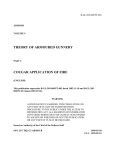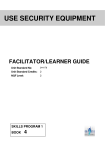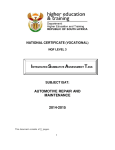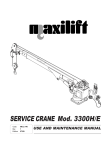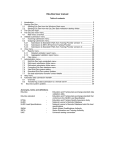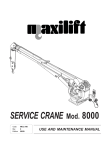Download ELECTRICAL WORKMANSHIP NQF LEVEL 4
Transcript
NATIONAL CERTIFICATES (VOCATIONAL) ASSESSMENT GUIDELINES ELECTRICAL WORKMANSHIP NQF LEVEL 4 IMPLEMENTATION: JANUARY 2015 ELECTRICAL WORKMANSHIP– LEVEL 4 CONTENTS SECTION A: PURPOSE OF THE SUBJECT ASSESSMENT GUIDELINES SECTION B: ASSESSMENT IN THE NATIONAL CERTIFICATES (VOCATIONAL) 1 2 3 4 5 6 7 8 9 10 11 12 13 Assessment in the National Certificates (Vocational) Assessment framework for vocational qualifications 2.1 Internal continuous assessment (ICASS) 2.2 External summative assessment (ESASS) Moderation of assessment 3.1 Internal moderation 3.2 External moderation Period of validity of internal continuous assessment (ICASS) Assessor requirements Types of assessment 6.1 Baseline assessment 6.2 Diagnostic assessment 6.3 Formative assessment 6.4 Summative assessment Planning assessment 7.1 Collecting evidence 7.2 Recording 7.3 Reporting Methods of assessment Instruments and tools for collecting evidence Tools for assessing student performance Selecting and/or designing recording and reporting systems Competence descriptions Strategies for collecting evidence 13.1 Record sheets 13.2 Checklists SECTION C: ASSESSMENT IN ELECTRICAL WORKMANSHIP – LEVEL 4 1 2 3 4 Schedule of assessment Recording and reporting Internal assessment of Subject Outcomes in Electrical Workmanship – Level 4 Specifications for external assessment in Electrical Workmanship – Level 4 4.1 Integrated summative assessment task (ISAT) 4.2 National examination Electrical Workmanship Level 4 Assessment Guidelines (January 2015) National Certificates (Vocational) SECTION A: PURPOSE OF THE SUBJECT ASSESSMENT GUIDELINES This document provides the lecturer with guidelines to develop and implement a coherent, integrated assessment system for the subject Electrical Workmanship Level 4 in the National Certificates (Vocational). It must be read with the National Policy Regarding Further Education and Training Programmes: Approval of the Documents, Policy for the National Certificates (Vocational) Qualifications at Levels 2 to 4 on the National Qualifications Framework (NQF). This assessment guideline will be used for National Qualifications Framework Levels 2-4. This document explains the requirements for internal and external subject assessment. The lecturer must use this document with the Subject Guidelines: Electrical Workmanship Level 4 to prepare for and deliver Electrical Workmanship. Lecturers should use a variety of resources and apply a range of assessment skills in the setting, marking and recording of assessment tasks. SECTION B: ASSESSMENT IN THE NATIONAL CERTIFICATES (VOCATIONAL) 1 ASSESSMENT IN THE NATIONAL CERTIFICATES (VOCATIONAL) Assessment in the National Certificates (Vocational) is underpinned by the objectives of the National Qualifications Framework (NQF). These objectives are to: Create an integrated national framework for learning achievements. Facilitate access to and progression within education, training and career paths. Enhance the quality of education and training. Redress unfair discrimination and past imbalances and thereby accelerate employment opportunities. Contribute to the holistic development of the student by addressing: social adjustment and responsibility; moral accountability and ethical work orientation; economic participation; and nation-building. The principles that drive these objectives are: • Integration To adopt a unified approach to education and training that will strengthen the human resource development capacity of the nation. • Relevance To be dynamic and responsive to national development needs. • Credibility To demonstrate national and international value and recognition of qualification and acquired competencies and skills. • Coherence To work within a consistent framework of principles and certification. 3 Department of Higher Education and Training Electrical Workmanship Level 4 Assessment Guidelines (January 2015) National Certificates (Vocational) • Flexibility To allow for creativity and resourcefulness when achieving Learning Outcomes;to cater for different learning styles and use a range of assessment methods, instruments and techniques. • Participation To enable stakeholders to participate in setting standards and co-ordinating the achievement of the qualification. • Access To address barriers to learning at each level in order to facilitate students’ progress. • Progression To ensure that the qualification framework permits individuals to move through the levels of the national qualification via different, appropriate combinations of components of the delivery system. • Portability To enable students to transfer credits of qualifications from one learning institution and/or employer to another. • Articulation To allow for vertical and horizontal mobility in the education system when accredited prerequisites have been successfully completed. • Recognition of Prior Learning To grant credits for a unit of learning following assessment or if a student possesses the capabilities specified in the outcomes statement. • Validity of assessments To ensure that assessment covers a broad range of the knowledge, skills, values and attitudes (KSVAs) needed to demonstrate applied competency. This is achieved through: clearly stating the outcome to be assessed; selecting appropriate or suitable evidence; matching the evidence with a compatible or appropriate method of assessment; and selecting and constructing an instrument(s) of assessment. • Reliability To ensure that assessment practices are consistent so that the same result or judgment is arrived at if the assessment is replicated in the same context. This demands consistency in the interpretation of evidence; therefore careful monitoring of assessment is vital. • Fairness and transparency To verify that no assessment process or method(s) hinders or unfairly advantages any student. The following could constitute unfairness in assessment: Inequality of opportunities, resources or teaching and learning approaches; Bias based on ethnicity, race, gender, age, disability or social class; Lack of clarity regarding Learning Outcome being assessed; Comparison of students’ work with that of other students, based on learning styles and language. • Practicability and cost-effectiveness To integrate assessment practices within an outcomes-based education and training system and to strive for cost and time-effective assessment. 4 Department of Higher Education and Training Electrical Workmanship Level 4 Assessment Guidelines (January 2015) National Certificates (Vocational) 2 ASSESSMENT FRAMEWORK FOR VOCATIONAL QUALIFICATIONS The assessment structure for the National Certificates (Vocational) qualification is as follows: 2.1 Internal continuous assessment (ICASS) Knowledge, skills values, and attitudes (SKVAs) are assessed throughout the year using assessment instruments such as projects, tests, assignments, investigations, role-play and case studies. The internal continuous assessment (ICASS) practical component is undertaken in a real workplace, a workshop or a “Structured Environment”. This component is moderated internally, and externally quality assured by Umalusi. All internal continuous assessment (ICASS) evidence is kept in a Portfolio of Evidence (PoE) and must be readily available for monitoring, moderation and verification purposes. 2.2 External summative assessment (ESASS) The external summative assessment is either a single (or a set of) written paper(s) set to the requirements of the Subject Learning Outcomes. The Department of Higher Education and Training (DHET) administers the theoretical component according to relevant assessment policies. A compulsory component of external summative assessment (ESASS) is the integrated summative assessment task (ISAT). This assessment task draws on the students’ cumulative learning throughout the year. The task requires integrated application of competence and is executed under strict assessment conditions. The task should take place in a simulated or “Structured Environment”. The ISAT is the most significant test of students’ ability to apply their acquired knowledge. The integrated assessment approach allows students to be assessed in more than one subject with the same ISAT. External summative assessments will be conducted annually between October and December, with provision made for supplementary sittings. 3 3.1 MODERATION OF ASSESSMENT Internal moderation Assessment must be moderated according to the internal moderation policy of the Further Education and Training (FET) college. Internal college moderation is a continuous process. The moderator’s involvement starts with the planning of assessment methods and instruments and follows with continuous collaboration with and support to the assessors. Internal moderation creates common understanding of Assessment Standards and maintains these across vocational programmes. 3.2 External moderation External moderation is conducted by the Department of Higher Education and Training, Umalusi and, where relevant, an Education and Training Quality Assurance (ETQA) body according to South African Qualifications Authority (SAQA) and Umalusi standards and requirements. The external moderator: monitors and evaluates the standard of all summative assessments; maintains standards by exercising appropriate influence and control over assessors; 5 Department of Higher Education and Training Electrical Workmanship Level 4 Assessment Guidelines (January 2015) National Certificates (Vocational) ensures that proper procedures are followed; ensures that summative integrated assessments are correctly administered; observes a minimum sample of ten (10) to twenty-five (25) percent of summative assessments; gives written feedback to the relevant quality assuror; and moderates in case of a dispute between an assessor and a student. Policy on inclusive education requires that assessment procedures for students who experience barriers to learning be customised and supported to enable these students to achieve to their maximum potential. 4 PERIOD OF VALIDITY OF INTERNAL CONTINUOUS ASSESSMENT (ICASS) The period of validity of the internal continuous assessment mark is determined by the National Policy on the Conduct, Administration and Management of the Assessment of the National Certificates (Vocational). The ICASS must be re-submitted with each examination enrolment for which it constitutes a component. 5 ASSESSOR REQUIREMENTS Assessors must be subject specialists and competent assessors. 6 TYPES OF ASSESSMENT Assessment benefits the student and the lecturer. It informs students about their progress and helps lecturers make informed decisions at different stages of the learning process. Depending on the intended purpose, different types of assessment can be used. 6.1 Baseline assessment At the beginning of a level or learning experience, baseline assessment establishes the knowledge, skills, values and attitudes that students bring to the classroom. This knowledge assists lecturers in planning learning programmes and learning activities. 6.2 Diagnostic assessment This assessment diagnoses the nature and causes of learning barriers experienced by specific students. It is followed by guidance, appropriate support and intervention strategies. This type of assessment is useful for making referrals for students requiring specialist help. 6.3 Formative assessment This assessment monitors and supports teaching and learning. It determines student strengths and weaknesses and provides feedback on progress. It determines if a student is ready for summative assessment. 6.4 Summative assessment This type of assessment gives an overall picture of student progress at a given time. It determines whether the student is sufficiently competent to progress to the next level. 6 Department of Higher Education and Training Electrical Workmanship Level 4 Assessment Guidelines (January 2015) National Certificates (Vocational) 7 PLANNING ASSESSMENT An assessment plan should cover three main processes: 7.1 Collecting evidence The assessment plan indicates which Subject Outcomes and Assessment Standards will be assessed, what assessment method or activity will be used and when this assessment will be conducted. 7.2 Recording Recording refers to the assessment instruments or tools with which the assessment will be captured or recorded. Therefore, appropriate assessment instruments must be developed or adapted. 7.3 Reporting All the evidence is put together in a report to deliver a decision for achievement in the subject. 8 METHODS OF ASSESSMENT Methods of assessment refer to who carries out the assessment and includes lecturer assessment, self-assessment, peer assessment and group assessment. LECTURER ASSESSMENT The lecturer assesses students’ performance against given criteria in different contexts, such as individual work, group work, etc. SELFASSESSMENT Students assess their own performance against given criteria in different contexts, such as individual work, group work, etc. PEER ASSESSMENT Students assess another student’s or group of students’ performance against given criteria in different contexts, such as individual work, group work, etc. GROUP ASSESSMENT Students assess the individual performance of other students within a group or the overall performance of a group of students against given criteria. 9 INSTRUMENTS AND TOOLS FOR COLLECTING EVIDENCE All evidence collected for assessment purposes is kept or recorded in the student’s Portfolio of Evidence (PoE). The following table summarises a variety of methods and instruments for collecting evidence. A method and instrument is chosen to give students ample opportunity to demonstrate that the Subject Outcome has been attained. This will only be possible if the chosen methods and instruments are appropriate for the target group and for the Specific Outcome being assessed. 7 Department of Higher Education and Training Electrical Workmanship Level 4 Assessment Guidelines (January 2015) National Certificates (Vocational) METHODS FOR COLLECTING EVIDENCE Observation-based Task-based Test-based (less structured) (Structured) (More structured) Observation Class questions Lecturer, student, parent discussions Assessment instruments Assignments or tasks Examinations Projects Practical examinations Investigations or research Case studies Practical exercises Class tests Oral tests Open-book tests Demonstrations Role-play Interviews Assessment tools Evidence Observation sheets Checklists Marks (e.g. %) Lecturer’s notes Rating scales Comments Rubrics Rating scales (1-7) Focus on individual students Open middle: Students produce the same evidence but in different ways. Subjective evidence based on lecturer observations and impressions Open end: Students use same process to achieve different results. Students answer the same questions in the same way, within the same time. 10 TOOLS FOR ASSESSING STUDENT PERFORMANCE Rating scales are marking systems where a symbol (such as 1 to 7) or a mark (such as 5/10 or 50%) is defined in detail. The detail is as important as the coded score. Traditional marking, assessment and evaluation mostly used rating scales without details such as what was right or wrong, weak or strong, etc. Task lists and checklists show the student what needs to be done. These consist of short statements describing the expected performance in a particular task. The statements on the checklist can be ticked off when the student has adequately achieved the criterion. Checklists and task lists are useful in peer or group assessment activities. Rubrics are a hierarchy (graded levels) of criteria with benchmarks that describe the minimum level of acceptable performance or achievement for each criterion. Using rubrics is a different way of assessing that cannot be compared to tests. Each criterion described in the rubric must be assessed separately. Mainly two types of rubrics are used, namely holistic and analytical. 8 Department of Higher Education and Training Electrical Workmanship Level 4 Assessment Guidelines (January 2015) National Certificates (Vocational) 11 SELECTING AND/OR DESIGNING RECORDING AND REPORTING SYSTEMS The selection or design of recording and reporting systems depends on the purpose of recording and reporting student achievement. Why particular information is recorded and how it is recorded determine which instrument will be used. Computer-based systems, for example spreadsheets, are cost and time effective. The recording system should be user-friendly and information should be easily accessed and retrieved. 12 COMPETENCE DESCRIPTIONS All assessment should award marks as evaluation of specific tasks. However, marks should be awarded against rubrics and should not simply be a total of ticks for right answers. Rubrics should explain the competence level descriptors for the skills, knowledge, values and attitudes that a student must demonstrate to achieve each level of the rating scale. When lecturers or assessors prepare an assessment task or question, they must ensure that it addresses an aspect of a Subject Outcome. The relevant Assessment Standard must be used to create the rubric to assess the task or question. The descriptions must clearly indicate the minimum level of attainment for each category on the rating scale. 13 STRATEGIES FOR COLLECTING EVIDENCE A number of different assessment instruments may be used to collect and record evidence. Examples of instruments that can be (adapted and) used in the classroom include: 13.1 Record sheets The lecturer observes students working in a group. These observations are recorded in a summary table at the end of each project. The lecturer can design a record sheet to record observations of students’ interactive and problem solving skills, attitudes towards group work and involvement in a group activity. 13.2 Checklists Checklists should have clear categories to ensure that the objectives are effectively met. The categories should describe how the activities are evaluated and against which criteria they are evaluated. Space for comments is essential. 9 Department of Higher Education and Training Electrical Workmanship Level 4 Assessment Guidelines (January 2015) National Certificates (Vocational) ASSESSMENT OF ELECTRICAL WORKMANSHIP LEVEL 4 10 Department of Higher Education and Training SECTION C: ASSESSMENT IN WORKSHOP PRACTICE AND ELECTRICAL WORKMANSHIP 1 ASSESSMENT SCHEDULE AND REQUIREMENTS Internal and external assessments are conducted and the results of both contribute to the final mark of a student in the subject The internal continuous assessment (ICASS) mark accounts for 50 percent and the external examination mark for 50 percent of the final mark. A student needs a minimum final mark of 50 percent to achieve a pass in the subject. 1.1 Internal assessment Lecturers must compile a detailed assessment plan and assessment schedule of internal assessments to be undertaken during the year in the subject (e.g. date, assessment task/or activity, rating code/marks allocated, assessor, moderator). All internal assessments are then conducted according to the plan and schedule using appropriate assessment instruments and tools for each assessment task (e.g. tests, assignments, practical tasks/projects and memoranda, rubrics, checklists). The marks allocated to the minimum number of both practical and written assessment tasks conducted during the internal continuous assessment (ICASS) are kept and recorded in the Portfolio of Evidence (PoE) which is subject to internal and external moderation. A year mark out of 100 is calculated from the ICASS marks contained in the PoE and submitted to DHET on the due date towards the end of the year. The following internal assessment units GUIDE the internal assessment of Electrical Workmanship Level 4. TASKS 1 Scope of assessment % contribution to the year mark Timeframe Type of assessment activity Minimum time and proposed mark allocation *(can be increased but not reduced) Term 1 Test 1 hour (50 marks) Topics completed in Term 1 10 Determined by the scope and nature of the task One or more of the topics completed as an assignment 25 Determined by the scope and nature of the task One or more of the topics completed as an assignment 25 Do not confuse the weightings of topics in the Subject Guidelines with the % contribution to the year mark Practical 2 Term 1 Assessment/ Assignment Practical 3 Term 2 Assessment/ Assignment 11 Department of Higher Education and Training 4 5 Term 2 Term 3 Test* 1 hour (50 marks) Internal Examination* As per external examinations Topics completed in Term 1 and 2 10 Topics completed to date (P1 & P2 where applicable) 30 (P1 =15 & P2=15, where applicable) TOTAL 100 Specifications for internal assessment may change over time. A separate internal assessment guideline document ‘Guidelines for the Implementation of Internal Continuous Assessment (ICASS) in the NC(V) qualifications at FET Colleges’ has been developed, and is updated and available on the Departmental website. The conduct and administration of internal assessments must always comply with specifications contained in the most current version of the guideline document 2 RECORDING AND REPORTING Electrical Workmanship is assessed according to five levels of competence. The level descriptions are explained in the following table. Scale of Achievement for the Vocational component RATING CODE RATING MARKS % 5 Outstanding 80 - 100 4 Highly Competent 70 - 79 3 Competent 50 - 69 2 Not yet competent 40 - 49 1 Not achieved 0 - 39 The planned and scheduled assessment should be recorded in the lecturer’s Portfolio of Assessment (PoA) for each subject. The minimum requirements for the Lecturer’s Portfolio of Assessment should be as follows: Lecturer information A contents page Subject and Assessment Guidelines A subject Year Plan /Work Scheme/Pace Setter A subject assessment plan Instrument(s) (tests, assignments, practical) and tools (memoranda, rubrics, checklists) for each assessment task A completed pre-moderation checklist for each of the ICASS tasks and their accompanying assessment tools A completed post-moderation checklist once the task has been administered and assessed 12 Department of Higher Education and Training Subject record sheets per level/class reflecting the marks achieved by students in the ICASS tasks completed Evidence of review – diagnostic and statistical analysis, including notes on improvement of the task for future use. The college could standardise these documents. The minimum requirements for the student’s Portfolio of Evidence (PoE) should be as follows: Student information/identification Declaration of authenticity form – duly completed (signed and dated) A contents page/list of content (for accessibility) A subject assessment schedule The evidence of marked assessment tasks and feedback according to the assessment schedule A summary record of results showing all the marks achieved per assessment for the subject Evidence of moderation (only where applicable for student’s whose tasks were moderated). Where tasks cannot be contained as evidence in the Portfolio of Evidence (PoE), their exact location must be recorded and they must be readily available for moderation purposes. 3 INTERNAL ASSESSMENT OF SUBJECT OUTCOMES IN ELECTRICAL WORKMANSHIP- LEVEL 4 Topic 1: Safety SUBJECT OUTCOME 1.1 Apply safety in the workplace ASSESSMENT STANDARD LEARNING OUTCOME The effects of electrical accidents on humans and property are explained Explain the effects of electrical accidents on humans and property Potential causes of harm to workers are explained Explain potential causes of harm to workers Range: injury, health effects, quality of life, machinery, handling processes, hazardous substances, slips, trips and falls, workplace conditions Safe work practices with electrical equipment and power tools are described Describe safe work practices with electrical equipment and power tools 13 Department of Higher Education and Training Risk assessment procedures in the workplace are performed and applied Perform and apply risk assessment procedures in the workplace Range: Probability – very likely, likely, unlikely, highly unlikely Consequences – fatality, major, minor, negligible Priority : 1&2 – high priority; 3&4 – medium priority; 5&6 – low priority Reasons for implementation of hazard control in the workplace are explained Explain why a workplace should implement hazard control The hierarchy of control and its use is described Describe the hierarchy of control and how it is used ASSESSMENT TASKS OR ACTIVITIES Theoretical assessment Assess the student on the achievement of the learning outcomes listed Practical assessment Students Identify hazards in the workplace Perform a risk assessment at the workplace The students must also be continuously assessed on safety aspects for the duration of their practical training Students must continuously implement safe work practices to control risks. Topic 2: Typical electrical installations SUBJECT OUTCOME 2.1 Describe typical electrical installations ASSESSMENT STANDARD LEARNING OUTCOME Electrical drawing symbols are identified and interpreted from diagrams Identify and interpret electrical drawing symbols from diagrams Basic electrical control circuits are designed, drawn and explained Design, draw and explain basic electrical control circuits Range: Three-heat switch, energy regulator switch (simmerstat), geyser thermostat, direct on-line motor starter, lighting control with light sensor and timer Lighting, socket outlet, geyser, stove and distribution board circuits are designed, drawn and explained Design, draw and explain lighting, socket outlet, geyser, stove and distribution board circuits Range: lighting, including two way and intermediate switching 14 Department of Higher Education and Training SANS 10142-1 regulations are interpreted and applied Interpret and apply the SANS 10142-1 regulations Range: Regulations 5.1.3 ,5.2.5 , 5.2.6 , 5.2.7, 5.2.8, 5.4.3 ,6.1, 6.3.3, 6.3.6.6 and 6.2.7.1 The different types of short-circuits that can occur in an electrical installation ( including three-phase systems) are listed and explained List and explain the different types of shortcircuits that can occur in an electrical installation ( including three-phase systems) The consequences of short-circuits in an electrical installation are listed and explained List and explain the consequences of shortcircuits in an electrical installation The cross-sectional area of protective conductors with regard to thermal stresses due to currents of short duration are calculated Calculate the cross-sectional area of protective conductors with regard to thermal stresses due to currents of short duration Range: Sp = √ (I² t) ÷ k (SANS 60439-1) ASSESSMENT TASKS OR ACTIVITIES Theoretical assessment • Assess the student on the achievement of the learning outcomes listed Practical assessment Students are given basic electric circuit diagrams for identification and interpretation of electrical symbols. Circuit diagrams could include: House wiring diagrams Basic appliance machine diagrams Relay-contactor diagrams SANS 10142-1 regulations will be given in tests and exams with questions to test understanding of the regulation only. Example 1: State in your own words what is meant by Regulation 6.2.7.1 (Difference in voltage; voltage drop) Example 2: Draw a sketch to illustrate Regulation 5.4.3. (Surge protection) Topic 3: Illumination SUBJECT OUTCOME 3.1 Explain illumination and different lamp circuits ASSESSMENT STANDARD The terms used in illumination and their respective unit of measurement are explained LEARNING OUTCOME Explain terms used in illumination and their respective units of measurement Range: luminious flux, luminious intensity, luminious efficiency or efficacy, illuminance and luminance 15 Department of Higher Education and Training The characteristics of a good lighting scheme are listed List the characteristics of a good lighting scheme Light fitting classifications are listed and explained with the aid of diagrams With the aid of diagrams list and explain light fitting classifications Range: direct, semi-direct, indirect, semiindirect and general diffusing The design, principle of operation, circuitry needed, advantages and disadvantages of the different types of lamps are explained with the aid of sketches Explain with the aid of a sketch the design, principle of operation, circuitry needed, advantages and disadvantages of the different types of lamps Range: incandescent, tungsten halogen ( including low voltage halogen lamps), Hg- and Na-vapour, fluorescent lamps ( including compact fluorescent lamps) and LEDs The stroboscopic effect of fluorescent lamps and how it can be minimised are explained Explain the stroboscopic effect of fluorescent lamps and how it can be minimised The colour emitted, efficiencies, environmental impact, power consumption and life expectancy of different types of lamps are discussed and the best lamp for the application is chosen Discuss the colour emitted, efficiencies, environmental impact, power consumption and life expectancy of different types of lamps and choose the best lamp for the application ASSESSMENT TASKS OR ACTIVITIES Theoretical assessment Assess the student on the achievement of the learning outcomes listed Practical assessment Bayonet and Edison screw lamp cap types are described in terms of physical appearance and safety precautions according to current regulations and standards Student connects the different circuitry for the operation of the lamps Student is given a scenario and must select the best type of lamp for the application taking into account the operating and environmental conditions of the installation Topic 4: Domestic appliances and portable electrical power tools SUBJECT OUTCOME 4.1 Fault-find, repair and test domestic appliances and portable electrical power tools Range includes but is not limited to: Domestic appliances such as kettles, steam irons, stoves, geysers, washing machines and tumble dryers. Electric and battery operated power tools such as hand-drills, grinders, orbital sanders and jigsaws. Single phase and either fixed-wired or connected by means of a plug top ASSESSMENT STANDARD The techniques used to identify the cause of, and to locate faults or faulty components in domestic appliances and portable power LEARNING OUTCOME Describe the techniques used to identify the cause of, and to locate faults or faulty components in domestic appliances and 16 Department of Higher Education and Training tools are described portable power tools Range: Observation, asking customer questions, simulation, measurement, sound, smell, identification of loss of function, comparison, previous fault occurrence and using manufacturer’s service manual Fault-finding is performed on domestic appliances and portable electrical power tools including electrical appliances and tools fitted with motors Fault-find domestic appliances and portable electrical power tools including electrical appliances and tools fitted with motors Domestic appliances and portable electrical power tools are repaired to fully serviceable condition Repair domestic appliances and portable electrical power tools to fully serviceable condition The procedure for safe testing of domestic appliances and portable electrical power tools are explained to ensure that it is safe to connect to the mains supply Explain the procedure for safe testing of domestic appliances and portable electrical power tools to ensure that it is safe to connect to the mains supply ASSESSMENT TASKS OR ACTIVITIES Theoretical assessment Assess the student on the achievement of the learning outcomes listed Practical assessment Student is given a domestic appliance or portable electrical power tool to repair and test. Included is documentation such as the manufacturer's service manual Alternatives causes of the fault symptoms are assessed and evaluated before making a decision as to the likely cause e.g. mechanical/electrical, control circuit/power circuit and using wiring diagrams Viability of repair is assessed taking into consideration component availability, cost and time to repair, cost of replacement of appliance and tools or customer instructions Isolation of the device from power supply is carried out in accordance with industry practice Replacement wiring matches the original Range: length, type, current rating, insulation voltage, temperature rating and rigidity or flexibility Flexible cord is selected and terminated to match plug and cord connector length and environmental factors Range: termination includes matching conductors to terminals, colour code, terminal screws are tightened, earth conductor is installed so that it will suffer least and last under cord tension, cord clamp is secured so that conductors are not strained, flexible cord insulation is maintained, all cords are tested for continuity, polarity and insulation resistance and results are recorded Quality control and complete a quality control inspection check-list for the repair and testing Range: Loosening, dismantling, replacing, assembling and tightening according to manufacturer’s specifications. Replace worn components and parts such as switches, chucks, brushes, bushes, bearings, frayed cords and cables, cracked plugs and connectors, oven and oven elements, plates, oven thermostats, timers and motors. 17 Department of Higher Education and Training Topic 5: Electric machines and control gear SUBJECT OUTCOME 5.1 Install, test and commission electrical machines Range: DC: Series, shunt and compound motors AC: capacitor-start capacitor-run, permanent capacitor, capacitor-start induction-run, resistance-start induction run, and universal motors including three-phase induction motors Protective features incorporated in motor starters, including over current, no-volt, phase reversal and phase failure ASSESSMENT STANDARD The preparation for installing electrical machines is described LEARNING OUTCOME Describe the preparation for installing electrical machines Range: Check electrical supply, suitability for operating environment, inspection of machines for damage, lubrication, cleanliness, foundation Electrical machines are installed Install electrical machines Range: Positioning, alignment of shaft, electrical connections, control and protection equipment, installation of guards and covers Electrical machines are tested and commissioned Test and commission electrical machines Range: Commissioning includes tests, adjustments and conformation of operation of control equipment such as switch gear, overtemperature, open-circuit, short-circuit and overload protection, direction of rotation, temperature rise and current drawn Electrical machines and control gear are overhauled Overhaul electrical machines and control gear Range: Mechanical and electrical inspections including testing of brush spring pressure and brush-arm insulation, replacing bearing and seal, replacing damaged parts, cleaning of parts, replacing capacitors, relays and protection devices ASSESSMENT TASKS OR ACTIVITIES Theoretical assessment Assess the student on the achievement of the learning outcomes listed Practical assessment Test and identify the terminals of a DC machine Measure armature resistance of a DC machine Test a DC machine for continuity and insulation resistance Connect, start, run and reverse a DC series, shunt and compound motor Overhaul a DC machine 18 Department of Higher Education and Training Identify the terminals of a three-phase induction motor Test a three-phase induction motor for insulation resistance Connect a three-phase induction motor through a D.O.L starter and a manual reversing switch Connect a three-phase induction motor by star-delta starter Connect, start, run and reverse direction of rotation of capacitor-start capacitor-run, permanent capacitor, capacitor-start induction-run, resistance-start induction run, and universal motors Sequence the starting of two three-phase AC squirrel cage induction motors Complete a motor test report form (single and three-phase) Overhaul an AC machine. 4 4.1 SPECIFICATION FOR EXTERNAL ASSESSMENT IN ELECTRICAL WORKMANSHIP – LEVEL 4 Integrated summative assessment task (ISAT) A compulsory component of the external assessment (ESASS) is the integrated summative assessment task (ISAT). The ISAT draws on the students’ cumulative learning achieved throughout the year. The task requires integrated application of competence and is executed and recorded in compliance with assessment conditions. Two approaches to the ISAT may be as follows: The students are assigned a task at the beginning of the year which they must complete in phases during the year to obtain an assessment mark. A final assessment is made at the end of the year when the task is completed; OR Students achieve the competencies during the year but the competencies are assessed cumulatively in a single assessment or examination session at the end of the year. The ISAT is set by an externally appointed examiner and is conveyed to colleges in the first quarter of the year. The integrated assessment approach enables students to be assessed in more than one subject with the same ISAT. 4.2 National Examination A national examination is conducted annually in October or November by means of a paper(s) set and moderated externally. The following distribution of cognitive application is suggested: LEVEL 4 KNOWLEDGE AND COMPREHENSION APPLICATION ANALYSIS, SYNTHESIS AND EVALUATION 30 - 40% 50 - 60% 0 - 20% 19 Department of Higher Education and Training























